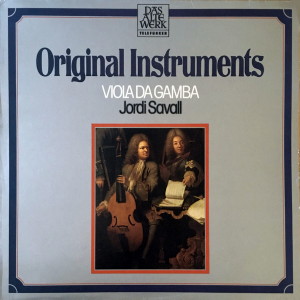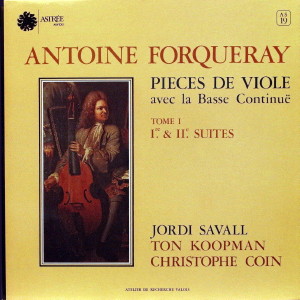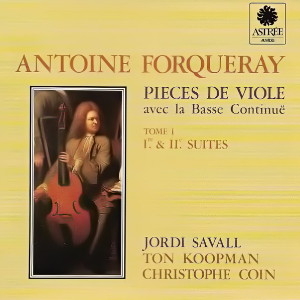 |
1 LP -
Telefunken 6.42366 AP (p) 1978
|
 |
| 1 LP -
Astrée AS 19 (p) 1978 |
 |
| 1 CD -
Astrée E 7762 (c) 1988 |
|
ORIGINALINSTRUMENTE - Viola da
gamba
|
|
|
|
|
|
|
|
| Antoine Forqueray
"Le Père" (1672-175) |
Suite
Nr. 1 d-moll |
|
25' 58" |
|
| Pièces
de Viole |
-
Allemande. La Laborde |
6' 23" |
|
A1 |
|
-
La Foruqeray |
2' 45" |
|
A2 |
|
-
La Cottin |
3' 15" |
|
A3 |
|
-
La Bellemont |
5' 09" |
|
A4 |
|
-
La Portugaise |
4' 11" |
|
A5 |
|
-
La Couperin |
4' 15" |
|
A6 |
|
Suite
Nr. 2 G-dur |
|
22' 54" |
|
|
-
La Bouron |
4' 13" |
|
B1 |
|
-
La Mandoline |
5' 22" |
|
B2 |
|
-
La Du Breüil |
4' 34" |
|
B3 |
|
-
La Leclair |
3' 02" |
|
B4 |
|
-
Chaconne. La Buisson |
5' 43" |
|
B5 |
|
|
|
|
|
| Jordi SAVALL,
Baß-Viola da gamba, siebensaitig,
Barak Norman, London 1697 |
|
| Ton KOOPMAN,
Cembalo, Pierre Bellot, 1729
(Musée de l'Archevêché, Chartres) |
|
| Christophe COIN,
Baß-Viola da
gamba, siebensaitig, Guy Derat,
nach Nicolas Bertrand, 1720 |
|
|
|
|
|
Luogo
e data di registrazione |
|
Saint-Lambert-des-Bois,
Yvelines (Francia) - ottobre 1977 |
|
|
Registrazione:
live / studio |
|
studio |
|
|
Producer |
|
Michel
Bernstein
|
|
|
Recording
Supervision
|
|
Benjamin
Bernfeld, Pere Casulleras |
|
|
Edizione LP |
|
TELEFUNKEN
- 6.42366 AP - (1 LP - durata 49'
30") - (p) 1978 - Analogico |
|
|
Originale LP
|
|
ASTRÉE
- AS 19 - (1 LP - durata 49' 30")
- (p) 1978 - Analogico |
|
|
Prima Edizione CD |
|
ASTRÉE - E 7762 -
(1 CD - durata 49' 30") - (c)
1988 - AAD |
|
|
Note |
|
Produced
by Astrée |
|
|
|
|
The viola
da gamba has been
known since about
1500 and is of
Spanish or Italian
origin. Although
the scientific
language
interpretation of
the name is
disputed, it is
nevertheless
remarkable that
the name viola
(Italian) or viole
(French) is
associated with
the Provencal
violar: to play
the vielle
(fiddle). From the
16th century
onwards, however,
the terms fiddle
and to fiddle were
increasingly used
in a derogatory
sense: the viols
had developed from
their use as a
minstrel’s
instrument into a
favoured
instrument of the
music-making
bourgeoisie and
music performance
at court. The
addition “da
gamba” indicates
that the
instrument is held
with the knees (in
Italian “gamba”)
as opposed to the
viola da brazzio,
held by the arm.
Its method of
construction is
characteristic,
with the body
tapering upwards,
with the flat base
slanting,
sometimes
rooflike, up to
the neck, the
curved sides and
the
outward-pointing
C-shaped sound
holes, as well as
the frets attached
to the fingerboard
at semi-tone
intervals. In most
cases there is a
further sound hole
on the soundboard
before the bridge,
artistically
designed as a
rosette. Since the
16th century six
strings have been
the rule, and for
playing in
ensemble, as was
cultivated in
England, France,
the Netherlands
and Germany, there
were instruments
in various
tunings. From
these emerged as
the most important
instrument the
French tenor bass
tuning, the basse
de viole, also
referred to simply
as the viole, with
the abbreviated
description of
gamba. The
present-day double
bass resulted from
the contrabasso da
gamba (also the
violone).
Solo gamba music
originated in
France, and
Saint-Colombe, one
of the many
virtuosos at the
time of Louis XIV,
introduced in 1675
a seventh string
in order to expand
the performance
possibilities.
Italian violin
makers on the
other hand did not
go in for building
gambas, and the
instrument does
not play a
noteworthy part in
Italian music. In
Germany it was
certainly regarded
as a tonal
enrichment and an
alternative to the
cello. Bach for
instance used the
cello throughout
in the orchestra
and in chamber
music, but
accorded
appropriate tasks
to the viola da
gamba with the
three sonatas, the
arias with
obbligato gamba in
the Passions and
in the sixth
Brandenburg
Concerto. The
change in style in
the middle of the
18th century
pushed the viola
da gamba into the
background. Thanks
to the
preoccupation with
baroque music over
the past fifty
years or so,
interest has been
revived in the
viola da gamba.
Recent work
connected with
solo gamba music
has acknowledged
the singularity of
the seven-string
gamba and its
applicability to
such music. An
instrument of this
kind is played in
this recording.
Antoine Forqueray
(1672-1745) was in
his day a famous
viola da gamba
player and Maitre
de Musique to the
Duke of Orleans.
The movements of
his suite are
provided with
headings which
have to be
construed, in the
sense of
Couperin’s
harpsichord works,
as musical
portraits or genre
pictures, one of
which he dedicated
to his famous
contemporary and
to himself.
Gerhard
Schuhmacher
(English
translation by
Frederick A.
Bishop)
|
|
|

